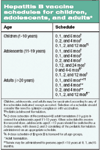CDC updates hepatitis B vaccine recommendations
In an attempt to eradicate hepatitis B virus (HBV) from the United States, the Centers for Disease Control & Prevention Advisory Committee on Immunization Practices (ACIP) issued updat-ed guidelines for vaccination against the disease.
In an attempt to eradicate hepatitis B virus (HBV) from the United States, the Centers for Disease Control & Prevention Advisory Committee on Immunization Practices (ACIP) issued updat-ed guidelines for vaccination against the disease. The first of two parts, the report was published in the Dec. 23 issue of Morbidity and Mortality Weekly Report (MMWR).
Part I focuses on infants, children, and adolescents and provides recommendations to improve prevention of perinatal and early childhood HBV transmission by way of universal infant vaccination beginning at birth and by increased coverage among previously unvaccinated children and adolescents.
The agency has supplemented the new guidelines with strategies for implementation.

According to the CDC, overall incidence of reported acute hepatitis B has already declined 75% from 8.5 to 2.1 per 100,000 population between 1990 and 2004.
Despite the good news, even with >95% of pregnant women being tested for hepatitis B surface antigen (HBsAg), only 50% of births to HBsAg-positive women were identified for case management, which usually ensures the necessary administration of postexposure immunoprophylaxis for the infant. In other words, according to CDC, there needs to be better care for women with no prenatal care who have higher prevalence of seropositivity than for women who are screened prior to delivery. Even when testing does occur, many infants of positive mothers do not receive immunoprophylaxis, due to testing errors or lapses in reporting of test results. Moreover, only 50% to 60% of adolescents aged 13 to 15 years are fully vaccinated against hepatitis B, and birth doses of the vaccine were administered to only 46% of infants in 2004.
The CDC recommends that the following measures be taken to reach the goal of disease eradication:
– Infants born to mothers who are HBsAg-positive should receive hepatitis B vaccine and hepatitis B immune globulin (HBIG) ≤12 hours of birth.
– Infants born to mothers whose HBsAg status is unknown should receive hepatitis B vaccine ≤12 hours of birth. The mother should have blood drawn as soon as possible to determine her HBsAg status; if the mother is found to be HBsAg-positive, the infant should receive HBIG as soon as possible (no later than one week of age).
– Full-term infants who are medically stable and who weigh ≥2000 gm and who are born to HBsAg-negative mothers should receive single-antigen hepatitis B vaccine before hospital discharge.
– Preterm infants weighing <2000 gm and who are born to HBsAg-negative mothers should receive the first dose of vaccine one month after birth or at hospital discharge.
– All infants should complete the hepatitis B vaccine series with either single-antigen vaccine or combination vaccine, according to a recommended vaccination schedule.
– Infants who are born to HBsAg-positive mothers should be tested for HBsAg and antibody to HBsAg after completion of the hepatitis B vaccine series at age nine months to 18 months.
The second part of the ACIP statement, due out in October, will provide updated recommendations and strategies for hepatitis B vaccination in adults.
The guidelines and strategies for their implementation can be accessed at http://www.cdc.gov/mmwr/preview/mmwrhtml/rr5416a1.htm.
Targeted Drug Combination Reveals New Activity in Brain Tumors
December 28th 2021A combination of two targeted cancer drugs showed unprecedented, “clinically meaningful” activity in patients with highly malignant brain tumors that carried a rare genetic mutation, according to a clinical trial report by investigators from Dana-Farber Cancer Institute.